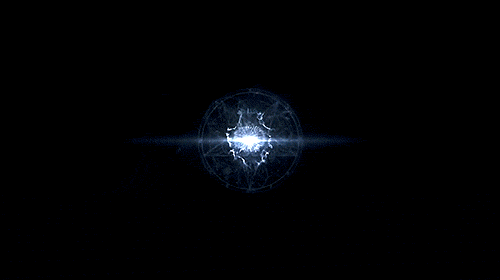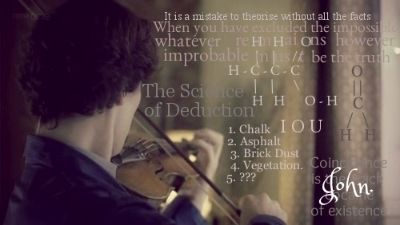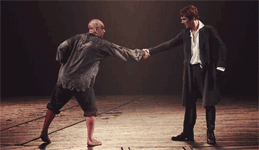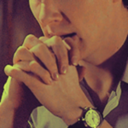
BBC Sherlock Fan Forum - Serving Sherlockians since February 2012.
- Sherlock Holmes
- Administrator
 Offline
Offline 
- From: 221B Baker Street
- Registered: February 7, 2012
- Posts: 5,162
Flaws In Theory #3
There's probably quite a few you all can think of but I just mentioned this in another thread and I've only just thought of this myself...
They threw the Sherlock lookalike out of the window in order for John to be able to see a body from the distance when he was rounding the corner, just before he was knocked over by the bike. Then, once he was on the ground, the lookalike was swapped with the real, alive Sherlock.
My question is, if John was only seeing the body from afar - which he was - why did it need to be the Sherlock lookalike in the first place? Why couldn't it just be a random dead guy with dark hair wearing one of Sherlock's coats? Why would they go to all the trouble of tracking down this lookalike guy if it wasn't necessary?
---------------------------------------------------------------------------------------------------------------------------------------------
Eventually everyone will support Johnlock.
Independent OSAJ Affiliate

- kittykat
- Reichenbach Survivor
 Offline
Offline 
- From: England
- Registered: June 17, 2013
- Posts: 4,740
Re: Flaws In Theory #3
I keep meaning to bring this up...
Sherlock calls Anderson "Phillip", but in the Casebook there's a forensics report of the cab driver Jeff Hope, filled out by S. Anderson...?
-----------------------------------------------------------------------------
Dean - "I'm not happy about it. But I got to move on. So I'm gonna keep doing what we do...while I still can. And I'd like you to be there with me."
Sam - "I'm your brother, Dean, if you ever need to talk about anything with anybody, you got someone right here next to you."

- dartmoordoggers
- Adler's Whip
 Offline
Offline - Registered: December 24, 2013
- Posts: 182
Re: Flaws In Theory #3
Sherlock Holmes wrote:
There's probably quite a few you all can think of but I just mentioned this in another thread and I've only just thought of this myself...
They threw the Sherlock lookalike out of the window in order for John to be able to see a body from the distance when he was rounding the corner, just before he was knocked over by the bike. Then, once he was on the ground, the lookalike was swapped with the real, alive Sherlock.
My question is, if John was only seeing the body from afar - which he was - why did it need to be the Sherlock lookalike in the first place? Why couldn't it just be a random dead guy with dark hair wearing one of Sherlock's coats? Why would they go to all the trouble of tracking down this lookalike guy if it wasn't necessary?
My guess is that a near lookalike would be preferable to cover for all eventualities. If John had sprung back up immediately after being hit by the bike they would not have had time to switch bodies; so the lookalike would be a better bet once John got closer. I also suspect that the lookalike would have been utilised for a number of the other scenarios.
- tobeornot221b
- One More Miracle
 Offline
Offline 
- From: Germany
- Registered: February 12, 2012
- Posts: 6,761
Re: Flaws In Theory #3
A lookalike Sherlock was clearly for us, the viewers. We saw him lying on the pavement - though it was only from a distance.
---------------------------------------------------------------------------------------------------------------------------------------------
John: "Have you spoken to Mycroft, Molly, uh, anyone?"
Mrs Hudson: "They don’t matter. You do."
I BELIEVE IN SERIES 5!

- Sherlock Holmes
- Administrator
 Offline
Offline 
- From: 221B Baker Street
- Registered: February 7, 2012
- Posts: 5,162
Re: Flaws In Theory #3
And we only saw his face once John came over.
---------------------------------------------------------------------------------------------------------------------------------------------
Eventually everyone will support Johnlock.
Independent OSAJ Affiliate

- •
- SolarSystem
- Threatened Knighthood
 Offline
Offline - From: Germany
- Registered: July 30, 2013
- Posts: 10,650
Re: Flaws In Theory #3
But why did they need a lookalike at all? Sherlock was there anyway, he had just landed on the blue airbag and got off it, he was exactly where he had to be! They could just have adjusted the fake blood right there. There was no need for him to cross the street so that the fake blood could be adjusted... that's what I don't understand. ![]()
___________________________________________________
"Am I the current King of England?
"I see no shame in having an unhealthy obsession with something." - David Tennant
"We did observe." - David Tennant in "Richard II"
- SusiGo
- The game is never over (moderator)
 Offline
Offline 
- From: Germany
- Registered: June 5, 2012
- Posts: 22,965
Re: Flaws In Theory #3
Assuming that our perspective at this very moment is identical with John's, we have to see a corpse lying on the pavement immediately after the fall. Everything else would be suspicious. Then John starts to cross the street to get to Sherlock and is hit by the cyclist to give them time for the exchange. That is how I understood it.
------------------------------
"To fake the death of one sibling may be regarded as a misfortune; to fake the death of both looks like carelessness." Oscar Wilde about Mycroft Holmes
"It is what it is says love." (Erich Fried)
“Enjoy the journey of life and not just the endgame. I’m also a great believer in treating others as you would like to be treated.” (Benedict Cumberbatch)

- SolarSystem
- Threatened Knighthood
 Offline
Offline - From: Germany
- Registered: July 30, 2013
- Posts: 10,650
Re: Flaws In Theory #3
SusiGo wrote:
Assuming that our perspective at this very moment is identical with John's, we have to see a corpse lying on the pavement immediately after the fall. Everything else would be suspicious. Then John starts to cross the street to get to Sherlock and is hit by the cyclist to give them time for the exchange. That is how I understood it.
But immediately after the fall there still was the blue airbag right in that position, wasn't there? I mean, come on, it surely doesn't take any longer for Sherlock to lie down on the ground than it takes to get that airbag out of the way...?
@swanpride: I don't really see why it should be more difficult to add a convincing wound while Sherlock is lying on the ground. But granted, I'm not an expert.
___________________________________________________
"Am I the current King of England?
"I see no shame in having an unhealthy obsession with something." - David Tennant
"We did observe." - David Tennant in "Richard II"
- dartmoordoggers
- Adler's Whip
 Offline
Offline - Registered: December 24, 2013
- Posts: 182
Re: Flaws In Theory #3
As someone else has said, in TRF we saw a body hit the pavement. If all we saw was Sherlock falling and then him lying on the ground a little later, we wouldnt have been discussing it for two years.
- Mary Me
- High Functioning Sociopath
 Offline
Offline 
- From: Germany, Bonn
- Registered: January 8, 2013
- Posts: 3,250
Re: Flaws In Theory #3
dartmoordoggers wrote:
Sherlock Holmes wrote:
There's probably quite a few you all can think of but I just mentioned this in another thread and I've only just thought of this myself...
They threw the Sherlock lookalike out of the window in order for John to be able to see a body from the distance when he was rounding the corner, just before he was knocked over by the bike. Then, once he was on the ground, the lookalike was swapped with the real, alive Sherlock.
My question is, if John was only seeing the body from afar - which he was - why did it need to be the Sherlock lookalike in the first place? Why couldn't it just be a random dead guy with dark hair wearing one of Sherlock's coats? Why would they go to all the trouble of tracking down this lookalike guy if it wasn't necessary?My guess is that a near lookalike would be preferable to cover for all eventualities. If John had sprung back up immediately after being hit by the bike they would not have had time to switch bodies; so the lookalike would be a better bet once John got closer. I also suspect that the lookalike would have been utilised for a number of the other scenarios.
This would be also my guess and it's the most logical one. Better be prepared for all scenarios.
~~~~~~~~~~~~~~~~~~~~~~~~~~~~~~~~~~~~~~~~~~
"Falling is just like flying, except there’s a more permanent destination."
"Sherlock Holmes is a great man, and I think one day—if we’re very very lucky—he might even be a good one."
"Would you like to-"
"-have dinner?"
"-solve crimes?"
"Oh"

- Wholocked
- Moderator
 Offline
Offline 
- From: Australia
- Registered: March 7, 2012
- Posts: 1,811
Re: Flaws In Theory #3
kittykat wrote:
I keep meaning to bring this up...
Sherlock calls Anderson "Phillip", but in the Casebook there's a forensics report of the cab driver Jeff Hope, filled out by S. Anderson...?
He knew Lestrade for five years before learning his name was Greg, and then upon his return he referred to him as Graham. If that is Sherlock talking to Anderson, I don't think he's a reliable source for his first name ;-)
However, since I believe that conversation is a figment of Anderson's imagination, I guess he would get his own name right. Maybe the "S" is a rank? Or maybe it's yet another canon nod to ACD getting people's names wrong.
Last edited by Wholocked (January 4, 2014 11:12 pm)
-------------------------------------------------------------------------------------------------------------
I dislike being outnumbered. It makes for too much stupid in the room

- besleybean
- Threatened Knighthood
 Offline
Offline 
- From: Carnoustie, Angus, Scotland.
- Registered: October 4, 2012
- Posts: 21,374
Re: Flaws In Theory #3
Maybe he has 2 names!
---------------------------------------------------------------------------------------------------------------------------------------------------------------
- shylock
- Homeless Network
 Offline
Offline - Registered: January 1, 2014
- Posts: 39
Re: Flaws In Theory #3
dartmoordoggers wrote:
Sherlock Holmes wrote:
There's probably quite a few you all can think of but I just mentioned this in another thread and I've only just thought of this myself...
They threw the Sherlock lookalike out of the window in order for John to be able to see a body from the distance when he was rounding the corner, just before he was knocked over by the bike. Then, once he was on the ground, the lookalike was swapped with the real, alive Sherlock.
My question is, if John was only seeing the body from afar - which he was - why did it need to be the Sherlock lookalike in the first place? Why couldn't it just be a random dead guy with dark hair wearing one of Sherlock's coats? Why would they go to all the trouble of tracking down this lookalike guy if it wasn't necessary?My guess is that a near lookalike would be preferable to cover for all eventualities. If John had sprung back up immediately after being hit by the bike they would not have had time to switch bodies; so the lookalike would be a better bet once John got closer. I also suspect that the lookalike would have been utilised for a number of the other scenarios.
But if John had sprung up immedeately after being hit by the bike he would have seen the bl**dy great air-bag with SH climbing off it, hardly covers all eventualities!
Again, why go to all that trouble if the only person to see it, not in on the scam, was John?
- Mary Me
- High Functioning Sociopath
 Offline
Offline 
- From: Germany, Bonn
- Registered: January 8, 2013
- Posts: 3,250
Re: Flaws In Theory #3
shylock wrote:
dartmoordoggers wrote:
Sherlock Holmes wrote:
There's probably quite a few you all can think of but I just mentioned this in another thread and I've only just thought of this myself...
They threw the Sherlock lookalike out of the window in order for John to be able to see a body from the distance when he was rounding the corner, just before he was knocked over by the bike. Then, once he was on the ground, the lookalike was swapped with the real, alive Sherlock.
My question is, if John was only seeing the body from afar - which he was - why did it need to be the Sherlock lookalike in the first place? Why couldn't it just be a random dead guy with dark hair wearing one of Sherlock's coats? Why would they go to all the trouble of tracking down this lookalike guy if it wasn't necessary?My guess is that a near lookalike would be preferable to cover for all eventualities. If John had sprung back up immediately after being hit by the bike they would not have had time to switch bodies; so the lookalike would be a better bet once John got closer. I also suspect that the lookalike would have been utilised for a number of the other scenarios.
But if John had sprung up immedeately after being hit by the bike he would have seen the bl**dy great air-bag with SH climbing off it, hardly covers all eventualities!
Again, why go to all that trouble if the only person to see it, not in on the scam, was John?
Hasn't that already occured to Anderson? What did Sherlock do in response? He sighed and walked away. Because of course it was a risky thing to do, extremely risky - but it worked out fine and this is what matters. Sometimes you just have to take the risk and do everything you can do.
~~~~~~~~~~~~~~~~~~~~~~~~~~~~~~~~~~~~~~~~~~
"Falling is just like flying, except there’s a more permanent destination."
"Sherlock Holmes is a great man, and I think one day—if we’re very very lucky—he might even be a good one."
"Would you like to-"
"-have dinner?"
"-solve crimes?"
"Oh"

- besleybean
- Threatened Knighthood
 Offline
Offline 
- From: Carnoustie, Angus, Scotland.
- Registered: October 4, 2012
- Posts: 21,374
Re: Flaws In Theory #3
We seem to have a few similar threads and I can see me having to say this all again, I also haven't read the whole of this page.
But I was musing over the Resolution, while lying in bed this morning and this is where I am with it at the moment!
We are shown Mycroft on his phone saying: so has it been done?
I took this to mean, Mycroft's sniper had shot John's sniper.
But presumably this could only be done after John's sniper signalled to the other snipers that Sherlock had jumped...so maybe he could only see what John saw? But then, why shoot him?
If he was just shot anyway, how would the other snipers know not to hit their marks?
I can understand that for the world, the news just had to get out that Sherlock had committed suicide. He needed to disppear and go off to clear the world of the Moriarty web.
But that doesn't account for the immediate problem of the individual snipers.
On a side note: do i take it that Sherlock travelled the globe and single handedly disposed of all of Moriarty's henchmen?
Last edited by besleybean (January 5, 2014 10:51 am)
---------------------------------------------------------------------------------------------------------------------------------------------------------------
- kuma
- Homeless Network
 Offline
Offline 
- From: Vn
- Registered: January 2, 2014
- Posts: 20
Re: Flaws In Theory #3
besleybean wrote:
We seem to have a few similar threads and I can see me having to say this all again, I also haven't read the whole of this page.
But I was musing over the Resolution, while lying in bed this morning and this is where I am with it at the moment!
We are shown Mycroft on his phone saying: so has it been done?
I took this to mean, Mycroft's sniper had shot John's sniper.
But preumably this could only be done after John's sniper signalled to the other snipers that Sherlock had jumped...so maybe he could only see what John saw? But then, why shoot him?
If he was just shot anyway, how would the other snipers know not to hit their marks?
I can understand that for the world, the news just had to get out that Sherlock had committed suicide. He needed to disppear and go off to clear the world of the Moriarty web.
But that doesn't account for the immediate problem of the individual snipers.
On a side note: do i take it that Sherlock travelled the globe and single handedly disposed of all of Moriarty's henchmen?
I suppose all the snipers were tracked by Mycroft's people and killed right before he took the phone call. But this just leads to another question: why didn't Mycroft just kill them all at first? Oh, maybe he wasn't sure how many people were at risks and who they are? Maybe he had to wait to hear that from Moriarty through Sherlock's phone?
About the main question, I've just replied in another topic. ![]()
- besleybean
- Threatened Knighthood
 Offline
Offline 
- From: Carnoustie, Angus, Scotland.
- Registered: October 4, 2012
- Posts: 21,374
Re: Flaws In Theory #3
Sigh. I'm having real issues here, cos I just cannot copy and paste easly on this forum,,,,so I'll have to write different bits on each of the threads!
---------------------------------------------------------------------------------------------------------------------------------------------------------------
- lil
- British Government
 Offline
Offline - Registered: June 19, 2013
- Posts: 645
Re: Flaws In Theory #3
The fake scenes were only filmed after the scripts including them were written, which means after the fall was written.
Didn't the writers say they filmed them to troll/fool/grab publicity? And that everything needed to explain the fall was filmed during S02 filming.
By drving ourselves crazy debugging the lame scenerio SH gave Anderson , we are falling into the trap Sherlock set for Anderson to drive him crazy?
The scene describing this theory seems to be a flashforward, Sherlock just realised Anderson set up the burnt skeleton crime scene to get Sherlocks attention, Sherlock deduces Andersons guilt and need for forgiveness , the same way he is fooling John to forgive him btw, and imagines what he will do to get revenge on Anderson.
The whole thing is in Sheroocks head.....maybe he did go see Anderson later and tell him this.....we don't know.
I hope he did , and tht he has something planned for Donovan too......
Last edited by lil (January 7, 2014 7:33 pm)
- Bruce Cook
- Lestrade's Aide
 Offline
Offline 
- From: Charlotte
- Registered: January 7, 2014
- Posts: 107
Re: Flaws In Theory #3
lil wrote:
The fake scenes were only filmed after the scripts including them were written, which means after the fall was written.
Didn't the writers say they filmed them to troll/fool/grab publicity? And that everything needed to explain the fall was filmed during S02 filming.
By drving ourselves crazy debugging the lame scenerio SH gave Anderson , we are falling into the trap Sherlock set for Anderson to drive him crazy?
The scene describing this theory seems to be a flashforward, Sherlock just realised Anderson set up the burnt skeleton crime scene to get Sherlocks attention, Sherlock deduces Andersons guilt and need for forgiveness , the same way he is fooling John to forgive him btw, and imagines what he will do to get revenge on Anderson.
The whole thing is in Sheroocks head.....maybe he did go see Anderson later and tell him this.....we don't know.
I hope he did , and that he has something planned for Donovan too......
Wow. Thanks, lil. I kept chewing my nails as I read the posts on this thread because I kept wanting to shout things like --
There was no shooter behind the sniper! Sherlock jumped to fool the sniper so he would call the other snipers off! In TRF we saw the sniper with John in the crosshairs for quite some time after Sherlock jumped, and then the sniper calmly packed up his rifle. It was his job to shoot John if Sherlock didn't jump, or not shoot John if Sherlock did. And either way, he would make a phone call to the other snipers to say shoot-or-don't-shoot.

There was no looka-like Sherlock body! No body was thrown out a window, because Sherlock simply laid on the ground after he rolled off a fireman's safety net -- which is the short "falling" scene we see.
There was no "convincing wound" on Sherlocks face! Just lots of blood smeared on it. There was no make-up artist standing nearby to put a fake wound on Sherlock's head real quick like. Oh, pa-leease.
And finally, there was no big blue air bag!
It would have been too big to hide from the sniper in the window across the street. He could easily have seen it at the end of the ambulance building from his position. And it would have taken too long to inflate and put into position after John's cab drove past the place where the crew got it ready! Plus there would be people in the half-dozen surrounding buildings who were not part of the hoax and who would report seeing it later. The way the team is shown lugging that big honkin' monster up and down the block, how could anyone have missed the damn thing!

However, a fireman's safety net could taken from the laundry truck, unfolded (they fold in half for transport), used to catch Sherlock, and put back in the truck in under thirty seconds. Few, if any, of the people in the surrounding buildings would have seen it because of the laundry truck which brought it and took it away. These nets were routinely used for jumpers up to six stories high. Sherlock only jumped from five stories (four floors and the roof).


I like this picture best of all. Is that Sherlock grinning up at the camera? Well, probably not . . .
KISS -- Keep It Simple, Sweetheart! Absolutely none of that "extra" crap was needed for the hoax. Sherlock was yanking Anderson's chain -- and I loved it. So, why are we debating "flaws" in a plan that was SUPPOSED to wrong?
Last edited by Bruce Cook (January 15, 2014 7:57 pm)
A good debate is like a fencing match — you don't have to win to get a good workout.
- hiatus
- Wrong!
 Offline
Offline - Registered: January 16, 2014
- Posts: 9
Re: Flaws In Theory #3
Yes, why the dead body at all? Sherlock could just be there, or if the lookalike was so good, he could be dead Sherlock. Why the complexity? Sherlock jumps, lays down, ketchup on, all good.
The only thing I can think is that it is a plot device. without the body you a) don't know why the kidnapped girl screamed at S. and b) there's no need for Molly's involvement at the scene, she could have falsified everything from her flat in her jammies..![]()
I'm always happy for a plot to have a couple of holes in it for the sake of a good story, so I'm good with it, but even so....the dead body is unnecessary..

 1
1